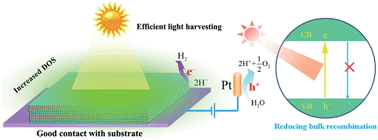Free-floating ultrathin tin monoxide sheets for solar-driven photoelectrochemical water splitting
Abstract
Solar-driven photoelectrochemical water splitting represents one of the most challenging tasks for solar-energy utilization. In this study, free-floating ultrathin SnO sheets with different thicknesses were successfully synthesized via a convenient liquid exfoliation strategy, with efforts to disclose the thickness-dependent solar water splitting efficiency in p-type semiconductors. The thinner thickness and larger surface area afford a higher fraction of surface atoms to serve as active sites, while the calculated increased density of states near the Fermi level ensures rapid carrier transport/separation efficiency along the two-dimensional conducting paths of the thinner SnO sheets. As expected, the 3 nm thick SnO sheet-based photocathode shows an incident photon-to-current conversion efficiency of up to 20.1% at 300 nm, remarkably higher than 10.7% and 4.2% for the 5.4 nm thick SnO sheet- and bulk SnO-based electrodes. This work discusses the thickness-dependent solar water splitting efficiency in ultrathin p-type semiconductor sheets, thus opening new opportunities in the field of solar cells and photocatalysts.


 Please wait while we load your content...
Please wait while we load your content...